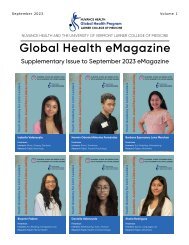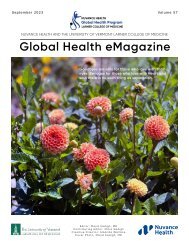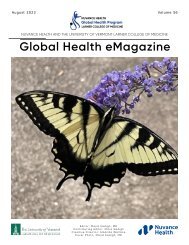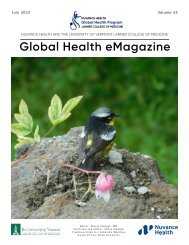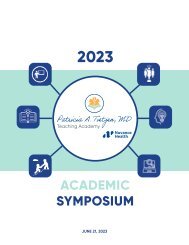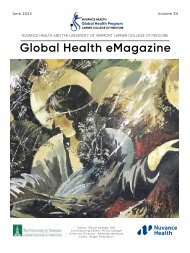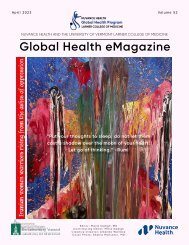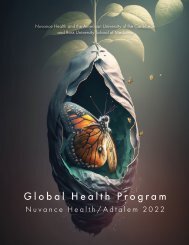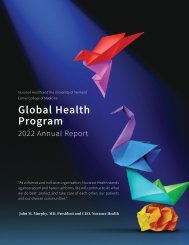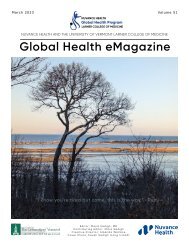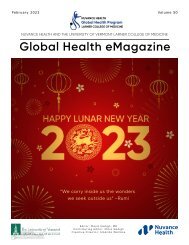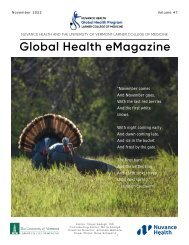eMagazine December 2022
Create successful ePaper yourself
Turn your PDF publications into a flip-book with our unique Google optimized e-Paper software.
OUR PEOPLE,<br />
OUR MISSION<br />
Global Health<br />
<strong>eMagazine</strong><br />
<strong>December</strong> <strong>2022</strong><br />
Perspective<br />
Highlights<br />
Welcome<br />
Congratulations<br />
Section Editor:<br />
Nursing Division<br />
Catherine G Winkler, PhD, MPH, APRN-BC<br />
Director of the Nuvance Health Global Health Program Nursing Division<br />
An Aging Population Across the World<br />
and Senior Care<br />
Written by<br />
Catherine G Winkler, PhD, MPH, APRN-BC<br />
Director of the Nuvance Health Global Health<br />
Program Nursing Division<br />
Article of the Month<br />
Video of the Month<br />
Ebola in Uganda<br />
Decolonization<br />
Innovation and Technology<br />
Among the Letters<br />
Nursing Division<br />
Art to Remind Us of Who<br />
We Can Be<br />
Reflections<br />
Our Beautiful Planet<br />
Upcoming Grand Rounds<br />
New Publication<br />
Global Health Family<br />
Calendar<br />
Photo Gallery<br />
Resources<br />
Part 1<br />
The population of the world is aging. Most countries are experiencing growth<br />
in the number and proportion of older people in their population (United<br />
Nations, <strong>2022</strong>). Overall, population aging is expected to be one of the most<br />
significant societal changes of this century impacting labor and financial<br />
markets, housing, healthcare, transportation, and goods and services as well as<br />
families, communities, and governments (United Nations, 202). All countries will<br />
inevitably face challenges in ensuring that their health as well as financial and<br />
social systems are prepared to adjust to this demographic shift (World Health<br />
Organization [WHO], <strong>2022</strong>). It is estimated that between 2015 and 2050, the<br />
proportion of people over 60 years old will nearly double from 12% to 22% (WHO,<br />
<strong>2022</strong>).<br />
According to WHO (<strong>2022</strong>), while this shift in distribution of a country’s population<br />
towards older ages started in high-income countries (for example in Japan<br />
30% of the population is already over 60 years old), it is now low- and middleincome<br />
countries that are experiencing this change in demographics. By 2050,<br />
two-thirds of the world’s population over 60 will live in low- and middle-income<br />
countries.<br />
Currently, about 25% of the world’s population is under 15 years old with only<br />
10% over 65 years old with countries in Africa having the youngest population<br />
worldwide (Statista, <strong>2022</strong>). In Africa specifically, 40% of the population is below<br />
age 15 and less than 4% are above 65 years of age. It is likely due to a very low<br />
life expectancy in some countries. In contrast, Europe and North America are<br />
expecting to have one in four persons aged 65+ by 2050 (United Nations, <strong>2022</strong>).<br />
How do we prepare for the demographic shifts in preparing societies around<br />
the world to meet the demands of a changing demographic? The rise of aging,<br />
frailty, and co-morbidities along with people leaving the workforce leads to<br />
increases in resource utilization of healthcare and insurance and an impact on<br />
financial and governmental services in some sectors.<br />
20<br />
Nursing continued on next page >>




